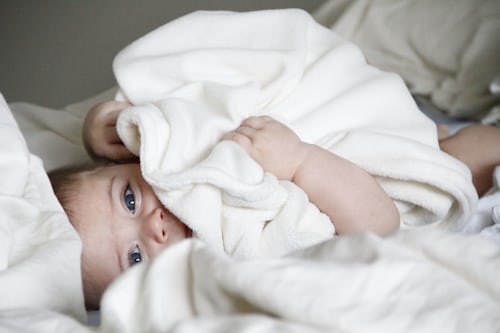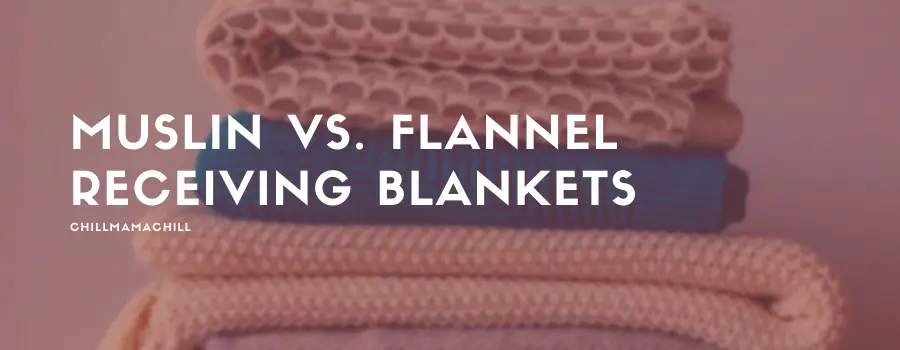As a new or experienced mum, you can attest to rocking your baby to sleep only for them to wake up the moment you place them in their crib. That’s a nightmare, especially when you’re sleep-deprived and yearning for a moment of peace. Seeing as the solution is swaddling, you wonder which to use with your child between muslin and flannel receiving blankets.
Muslin vs. flannel receiving blankets are made from different types of cotton fabric; the difference is how the material is woven. These two garments act as swaddles at various stages of your baby’s development or depending on temperature conditions. Muslin is lightweight, more flexible than flannel’s thicker weave and fibers. Such properties offer your baby softness as well as body heat retention and regulation.
So-called because of the reception they accord your newborn, receiving blankets are the first type of wrap or blanket in your baby’s life. Their main goal is to recreate womb life comfort and warmth for your child. Besides swaddling, you can use these wraps for burping, as part of bedding, after a bath, and to catch the mess of early self-feeding.
Muslin vs. Flannel Receiving Blankets: What’s the Difference?
The wrapping fabric for your baby must provide them with hugging, cuddling sensation. That’s if you want your little howler to quiet down, burp, or fall asleep. Swaddling helps your child get restful naps that improve their mood, which in turn boosts their immunity and overall health. That’s music to every mother out there, which is why it’s essential to select the best muslin vs. flannel receiving blankets.

How many muslin or flannel receiving blankets you’ll need depends on your laundry schedule. You should, however, keep at least four swaddling wrappers at hand, especially when your baby is tiny. As your child grows, you’ll turn from the smaller-sized receiving blanket to using a muslin catch-all. When learning to feed themselves or during spit-ups or blowouts, these extensive pieces of absorbent cloth will arrest the splatter.
Receiving blankets come in typical sizes of 30 square inches. A muslin swaddle can extend up to 50 inches square. The stand-out feature of this blanket is how versatile for use it is, seeing as you can use it in everything. When you’re feeding, changing, cuddling, or burping your tiny tot, this wrap-around is the go-to.
When Do I Start Using Muslin vs. Flannel Receiving Blankets?
At the beginning of your mothering journey, you’ll rely mostly on flannel receiving blankets. These will tide you through keeping your baby warm and cozy. When your child is burping, they’ll come in handy, acting as a super-sized burp cloth or fast mop-up cleaning rag for emergency spills.
Apart from that, you can apply amateur sewing skills to turn used receiving blankets into functional or sentimental items. That means you or your child will continue to use. Such include pajamas, bed caddies, room banners, garlands, and coiled flannel rope baskets. Beyond that, you can gift other upcoming mums or donate left-over blankets to animal shelters to liven up the critter’s cages.

As your tot grows, you’ll transition from receiving blankets to muslin swaddles as the much larger alternative. Seeing as muslin is lightly woven compared to flannel, you can alternatively turn the small-sized blankets into a quilt for use during cold weather. These swaddling sheets are stretchable and are elastic enough to tuck your baby in fully.
When you’re trying to ensure the comfort and safety of your child, you’ll find muslin vs. flannel receiving blankets useful and functional. Depending on your child’s size, need, or preference, each of these swaddling wrappers will get the job done.
Choose Muslin vs. Flannel Receiving Blankets as Your Child Grows
Are you are struggling to wrap your baby in the tight flannel receiving blankets? Then it’s time to move on to a more accommodating muslin swaddling blanket. For a good swaddle, you need a cloth that stretches underneath your child and can run to the ends of both sides. Muslin wrappers are made from gauze, a mildly stretchy and super lightweight form of cotton weave.
Flannel cotton isn’t stretchy enough, and commercially available receiving blankets just don’t cut in size. You may receive tons of them from other mums or as gifts during your baby shower. But you’ll soon be looking for other uses besides swaddling. By the time your baby is three months old, the little wrap will barely cover their tummy, let alone fold sideways for a snug fold.
While muslin feels coarse and scratchy when new, few washes later and its butter smooth. You can also make your swaddles with this fabric when you learn to hem a receiving blanket. Muslin blankets offer sizes of up to 47 inches square, and some come with closure mechanisms or shapes that promote swaddling.
How to Swaddle Your Baby Using a Muslin Blanket
Swaddling your tot means you’ll have to find a routine that’s comfortable for both of you. It’s a simple task that’s not tedious, and with repeated practice, you’ll soon become a master. To swaddle your baby with a muslin blanket;
- Fold the whole cloth into a diamond shape and lay your baby on its back at the center of the folds.
- Put your baby’s right arm parallel to their body and pull the swaddling blanket across the arm, under the left arm to its side. You can tuck the rest of the fabric into your child’s side. Ensure that the left arm is free.
- At the bottom where your baby’s feet are, fold the blanket upwards to a point underneath their chin. Ensure the swaddle is tight, and you can fold the pointed part down again.
- Wrap your baby’s chest and left arm with the rest of the blanket fabric. Use the hanging edges to tuck your child into a snug burrito-like shape.
Conclusion
While the differences between muslin and flannel receiving blankets are minimal, their use is varied and, for swaddles, specialized. You can easily select between these two essential accessories depending on your child’s size and how the temperatures will direct. However, despite not using flannels to swaddle, you’ll find that they continue being useful when you know how to squeeze more life out of them.

I’m Cathrine and I’m a 39-year-old mother of 3 from Utica, New York. And I’m extremely happy you’ve come to visit my hide-out on the web. Here I post about everything related to family-life and usually it will involve babies and lessons I’ve learned over the years from experts, friends, and my own mistakes. So hopefully you will find what i write fun and informational!


